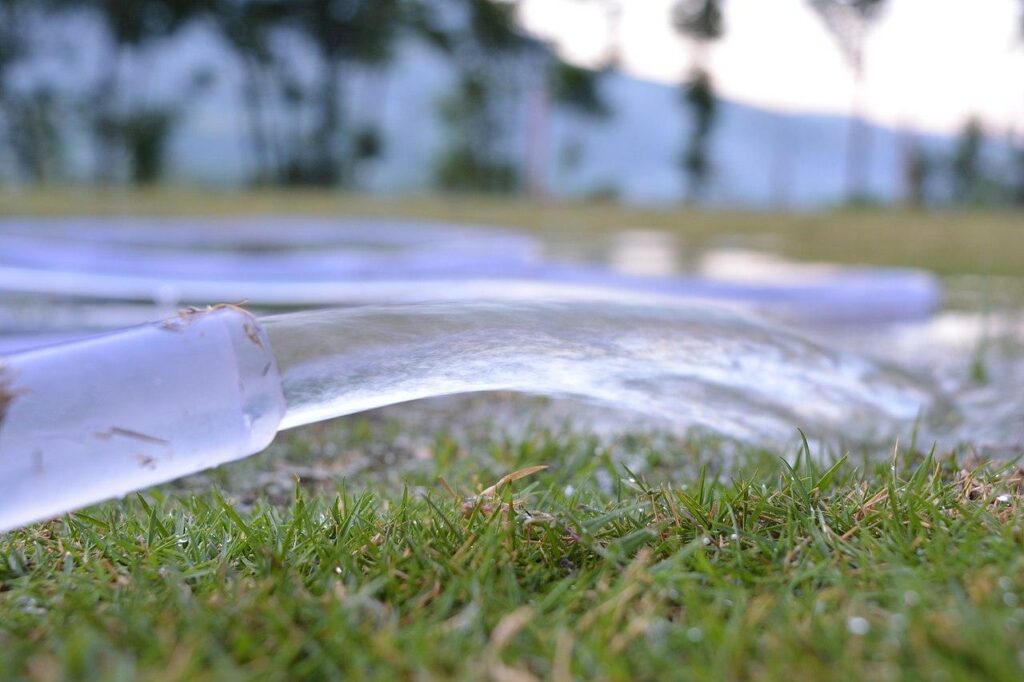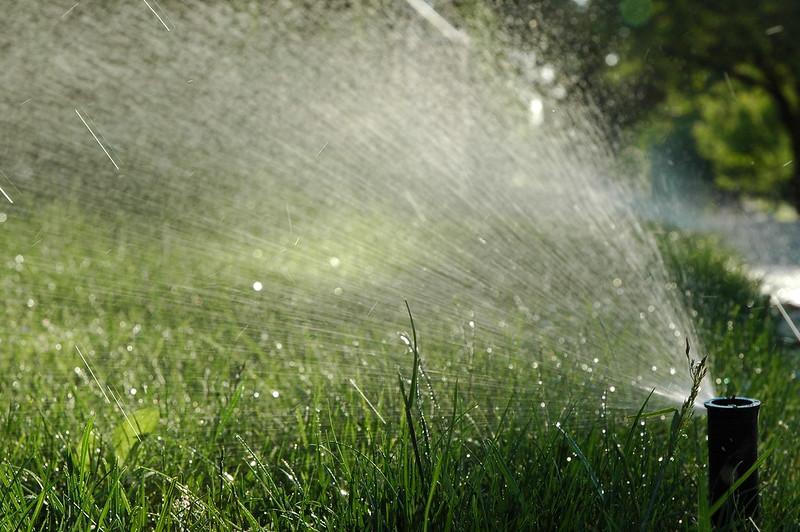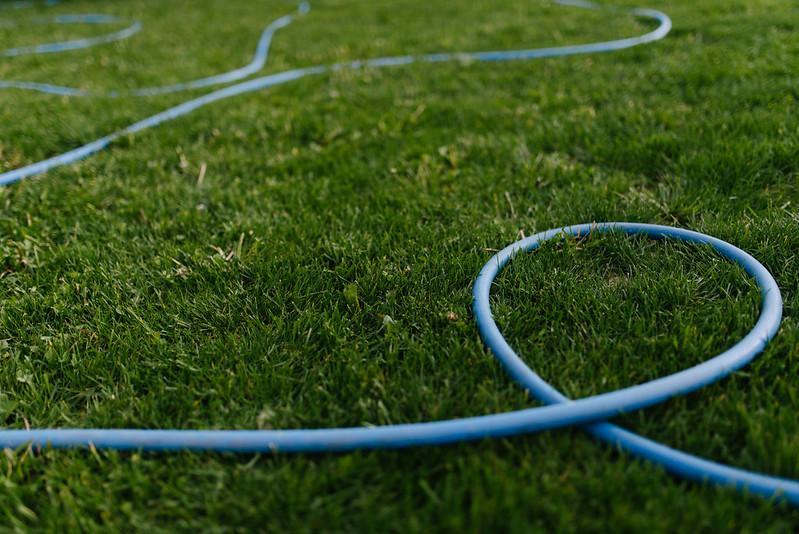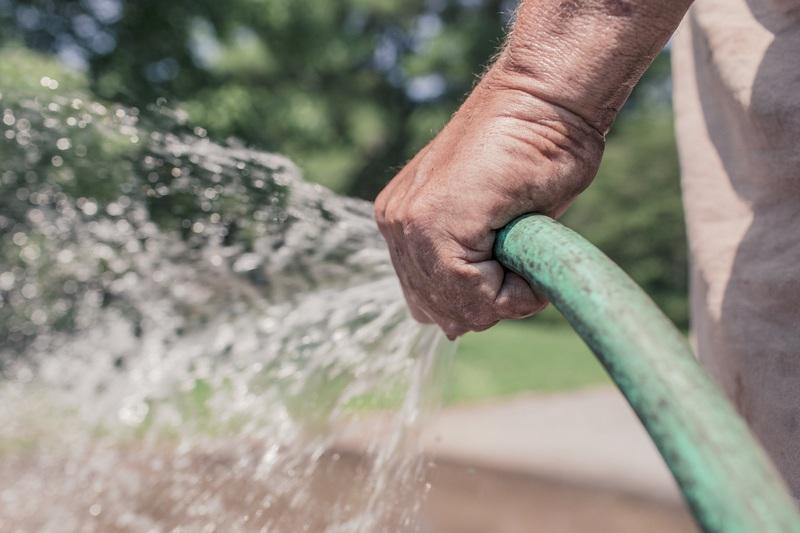When time is of the essence, and you need a new lawn quickly, laying sod is the way to go. Unfortunately, it’s not exactly cheap. The materials and labor for a professional installation of just 1000 square feet of sod can typically cost you upwards of $1,500. Even then, most landscapers will not guarantee you a healthy and blooming lawn. You’ll have to spend even more money to replace it if it dies. So, with that kind of investment at stake, you will need to give your lawn the attention and care it requires. In this article, let’s talk about watering new sod.

Watering new sod is an essential step in establishing your grass.
An essential component of post-installation care is ensuring that the new sod receives the appropriate amount of water. If you water your sod correctly, it will grow and become established in your yard more quickly.
We have compiled a comprehensive guide to watering new sod that addresses all of your concerns and offers a suggested watering schedule for new sod. If you follow this guide, we guarantee that your sod will flourish, and soon you will have a head-turning patch of grass in the neighborhood.
After installation, new sod needs to be watered for at least 45 minutes to allow the soil and lawn to absorb moisture that will aid in the rooting process. Don’t overwater your new sod, though.
Too much water on your new sod may cause the soil underneath it to become soggy and waterlogged. This will also stop new sod from building a robust root system. In addition, too much water makes sod more vulnerable to damage from insects, fungi, and diseases.
Tips For Watering New Sod

Water new sod with a proper irrigation system rather than a hose to ensure uniform application.
Once again, keeping your new sod adequately watered after installation is the key to establishing a lush green lawn. Here are a few tips to help you with this endeavor:
- The soil must be saturated with the initial heavy water application following sod installation. The first watering is the most important one, so be generous. After the initial irrigation, the water level should be between three and four inches deep.
- However, once you are done watering the new sod for the very first time, the grass now needs to be kept moist but not soaked. Keeping the grass soaked all the time will make it prone to fungal and pest attacks.
- It’s preferable to water deeply and infrequently than it is to water superficially and often. Roots will only grow to a depth that is equivalent to the depth of the water source that is available the most frequently.
- If you want to get the best possible results from your new sod, make sure to water it evenly using an irrigation system. Sprinklers provide more even and effective watering than hand watering manually with a hose.
- Do not let the new sod become dry and cracked. Most of the problems that arise in the first two weeks after sod installation are caused by insufficient availability of moisture to the developing grass and grass roots.
- Water your new sod and even established grass between 6 and 8 am. During this time, the wind speeds are lower and less water will be lost due to evaporation.
- Watering the grass in the evening is not recommended since any water left behind can encourage the growth of fungus and disease.
Related: How To Grow Sod In Shady Areas Of The Lawn? Best Sod For Shady Lawns
Water Freshly Installed Sod Right Away!

During the first watering of the new sod, deeply water the fresh sod to moisten the soil beneath it.
For turf to survive, it must have good ground contact and adequate moisture. So, immediately after installation, start watering newly laid sod. Apply at least 1 inch of water, so the turf’s underlying soil becomes saturated.
The top three to four inches of soil should be moist in an ideal scenario. Also, when working on large turf establishment projects, you should begin watering as soon as the first couple of pallets are placed down.
Early and thorough watering removes air pockets, improves root-to-soil contact, and, most critically, will prevent the sod from drying out. Peel back a corner of your fresh sod and touch the ground beneath it after the first watering.
The ground underneath the new sod ought to be damp, and water ought to have made its way through the soil layer of the sod. The duration of the initial watering should be between 30 and 80 minutes, depending on the following factors:
- How hot is it outside?
- Soil type
- Sprinkler system type/gallons per minute output (GPM)
- Wind Speed
Pro Tip: It is necessary to go back and rewater any areas that are dry multiple times. Also, before you lay the turfgrass sod, we strongly advise you to apply a starter fertilizer to the ground. This provides the sod with more nutrients, which will aid in the establishment of its root system.
Related: How Much Does Sod Weigh? Transporting & Taking Care Of Your Sod
Watering New Sod | Day 2 & Following 2 Weeks

If you live in a rainy area, include rain into your watering schedule to avoid overwatering.
The first two weeks following sod installation are essential. A single missed watering combined with summer heat can cause sod portions to shrink away from one another, resulting in a patchwork lawn. So, after the initial thorough watering, you will need to water the new sod 2 to 4 times each day to keep the lawn hydrated.
We advise watering the new sod at regular intervals between 7 am and 2 pm. Make sure that you are thoroughly watering the sod so that the moisture reaches all the way down to the roots and into the soil.
After watering for the first few days, you should be able to spot any dry places that aren’t receiving water. Also, pull out a section of sod on day 9 after watering to see if you can see fresh white roots. Once ten days have passed since the installation, you are ready to start cutting back the number of times per day that you water to just once.
Then, after 12 or 13 days, you will need to stop watering the new sod for 1 or 2 days. You need a slight dryness in your soil so you can walk on it. We don’t want you to sink into the dirt.
However, after this little break, you should start watering your grass once more, but this time for significantly more extended periods of time.
This modification in the watering schedule makes the grass more tolerant of drought and encourages it to look for deeper water sources.
Related: How Many Square Feet Are In A Pallet Of Sod | How Big Is A Pallet Of Sod?
Watering New Sod | Week 3 & 4

Once the grass is well-established, it will only need to be watered once or twice a week.
Once the margins of your new sod have grown together, and deep feeder roots have been established, switch to a more typical lawn watering schedule. Watering time should now be between 15 to 20 minutes for every cycle.
Week 3 is also when you will first mow the lawn. Use a walk-behind power mower with a high cutting height (3 inches). It is also recommended to leave grass clippings on the lawn so that nutrients can be returned to the soil.
Do not use a riding lawn mower on new sod. A riding mower is too hefty, and its driven wheels can rip away the new sod.
If you want your lawn to have the healthiest growth and look its best, you should make sure it receives around 1.5 inches of water per week from a combination of irrigation and rain. Check the water requirements of your sod type as well.
During the winter, reduce watering. Depending on the amount of rain and how much water is lost through evaporation, your grass may only need to be watered once or twice a month.
Additionally, continue to peel back the corners of the sod in order to see the roots that are developing. When you reach the point where you can no longer pull up a corner, it is time to water less frequently but do not stop completely.
An established lawn will need 1.5 inches of water per week for warm-season grasses and up to two inches per week for tall fescue.
Watering New Sod Vs. Established Lawn
The roots of lawn grass develop to a depth of around six inches into the earth while the grass grows in the field. The sod, on the other hand, is usually harvested together with a layer of soil and roots measuring only one inch thick.
When you install sod, the grass in your yard will need to re-establish its root system. For sod to accomplish this, you will need to water your sod more frequently.
After the grass has been established, its roots may grow several inches (or perhaps many feet) down into the soil.
When installing new sod on heavy clay, water only to the point where runoff occurs; however, when installing new sod on lighter soil, water the area immediately after installation with one to two inches of water.
In either scenario, the top three to four inches of the soil should be saturated with water.
Some More Tips For Watering New Sod
- To keep fresh sod moist in extreme heat, especially with tall fescue, it may be necessary to water it two to three times daily.
- You should check the level of moisture in your new sod many times a day, preferably once in the morning and once in the afternoon. If you observe that it is rapidly losing moisture, you should water it more frequently.
- New sod near paved surfaces will dry up considerably faster than the remainder of the new yard due to heat transfer from paved surfaces. So, pay close attention to the sod’s watering needs near driveways and walkways.
New Sod Watering Chart
For newly laid sod, it is best to adhere to a regular watering plan; however, it is important not to overwater the soil. For your convenience, here is a chart for watering new sod that summarizes all the information presented above.
| Period (Days) | Watering |
| Installation Day or First Day | Soak for 45 minutes.Soil should be moist 3 to 4 inches deep. |
| Day 2 to 7 | Water the new sod 2 to 4 times each day.Each watering session should be around 20 minutes. |
| Day 8 to 13 | Transition slowly to watering your lawn once a day.Also, increase the duration of watering to 30 minutes. |
| Day 14 to 28 | Mow the grass if it has reached the cutting heightAlso, shift to a more regular watering schedule |
| Day 28 and onwards | Choose a watering schedule according to your turf type |
Frequently Asked Questions (FAQs)
How often should newly laid sod be watered?
Your newly laid sod needs to be watered at least twice a day for a total of around twenty minutes per session, every single day, for the next four weeks.
However, once your new sod has formed deep feeder roots and the edges have come together, you should change to a regular watering schedule.
Can you water the new sod too much?
New sod takes a lot of water to root and establish itself, yet too much water can be just as bad as too little. You never want consistently wet soil beneath your fresh sod. New sod cannot absorb much water at once, and excessive amounts will result in root rot.
How long should you water the new sod for the first time?
Following sod installation, freshly laid sod needs to be watered for at least 45 minutes. Start watering large projects as soon as the first one or two pallets are placed. Water the new sod as early in the day as possible to allow the extra water to evaporate before night falls.
Will sod come back after turning brown?
Yes, brown sod can return to its original, lush, green appearance if treated immediately. The most effective revival methods consider the causes of grass turning brown. However, if the grass is dead, no amount of fertilization or watering will be able to revive it.
How long does the new sod take to root?
After being laid, sod takes 10 to 14 days to form its first shallow roots. However, it takes sod around six weeks to grow strong roots that result in a well-established lawn.
During this time, feeding the sod with a starting fertilizer and keeping it adequately watered might help to speed up the process and strengthen the grass.
Sources for Further Reading
Establishing a Lawn from Sod – Purdue University Extension Service
Seeding and sodding home lawns – University of Minnesota Extension Service
Establishing Lawns From Sod – University of Nebraska – Lincoln Turfgrass Science Program
Editor’s Recommendations
How To Plant Grass Seeds On Hard Dirt For Best Results? A Simple & Easy Guide
Push Mower Vs. Self-Propelled | How To Choose & Which Is Best For Your Lawn?
Pea Gravel Patio 101: Pros, Cons, Costs, Installation Guide & Much More!







